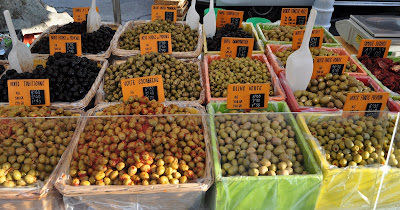Around 1180, the men of the Count of Toulouse built a wooden tower strengthened by palissages (trellises) on the top of this hill to impose the image of the Count’s power on the citizenry. This was pulled down on the bishop’s order and replaced in 1193-1195 by this stone keep castle. Later, two buildings were added. The castle was modified along the centuries.
We always enter the market by La Poste (the post office) where there is a display of pottery of all kinds and colors from La Poterie de Crestet. On that Tuesday morning back in March, I asked the vendor where his pottery was fabricated. I expected him to tell me it was made in Crestet, a small village east of Vaison, and to my surprise he responded "Espagne" (Spain). He continued on to say you can't sell pottery made in Provence for these low prices.
We love going to the weekly markets for many reasons, not the least of which, the produce on display inspire me to cook dishes which utilize the most seasonal ingredients. Here there is display with a large quantity of fresh garlic and radishes. You can click on any of these pictures to enlarge them.
A vendor with his tapenades.
A big pile of local green and white asparagus.
Purple artichokes
Several butchers come to the market every week and display their cuts of meats and charcuterie.
The first strawberries of the season from Carpentras.
A tasty assortment of cookies. We have to have cookies on hand when grandson Dylan comes to visit as he expects to find cookies at Papa's house. He is strictly limited on his cookie intake at home. Yes I know, I am spoiling him.
A table with a big pile of fresh roquette (arugula) and other greens for salads.
Dried fruits of all kinds.
An assortment of different kinds of olives. There are also seasoned olives perfect for enjoying with aperitifs.
You can buy fresh ravioli.
Rice, grains and dried beans of all varieties.
Ingredients for making tea.
Jams and jellies of all kind.
Several cheese vendors set up their shop at the market every week. Full disclosure, I don't buy from any of them since I am partial to the cheese that Josiane Deal sells at Lou Canesteou just a few steps away on Rue Raspail off Place Montfort, the town's main square.
You can buy spit-roasted chicken and potatoes roasted in the fat drippings to go.
Another butcher.
Jambon (ham) de Sanglier (wild boar).
Our favorite fish vendor. Guy also comes to Sablet on Thursday morning. Last summer he came to the Friday morning market in Sablet but he says he is not doing that market this year.
The other end of the large Lafond truck. They have an amazing assortment of fresh fish and shell fish.
Early in the day and season so the crowd is not wall to wall like it will be later in the day and certainly not like it will be this summer.
A vendor selling an assortment of foie gras preparations. My guess is that this is a display never seen in the US and will for sure not be seen in California after July 1 when the production and sale of foie gras is outlawed.
There are numerous sellers of saucissons, dry sausages.
Of course, there are many sellers of souvenirs including these towels.

One of the many sellers of tablecloths.
Soaps from Provence.
They even sell soap made from donkey's milk.
We always finish up market day with coffees at the newly renovated Festival Cafe on Place Montfort; many times with good friends like Barbara from Cuisine de Provence, a wonderful cook who offers classes at her home in Vaison-la-Romaine or with Bruce and Christine who live in nearby Villedieu.
Have a great weekend and enjoy the market. Happy cooking and à tres bientôt.
















































